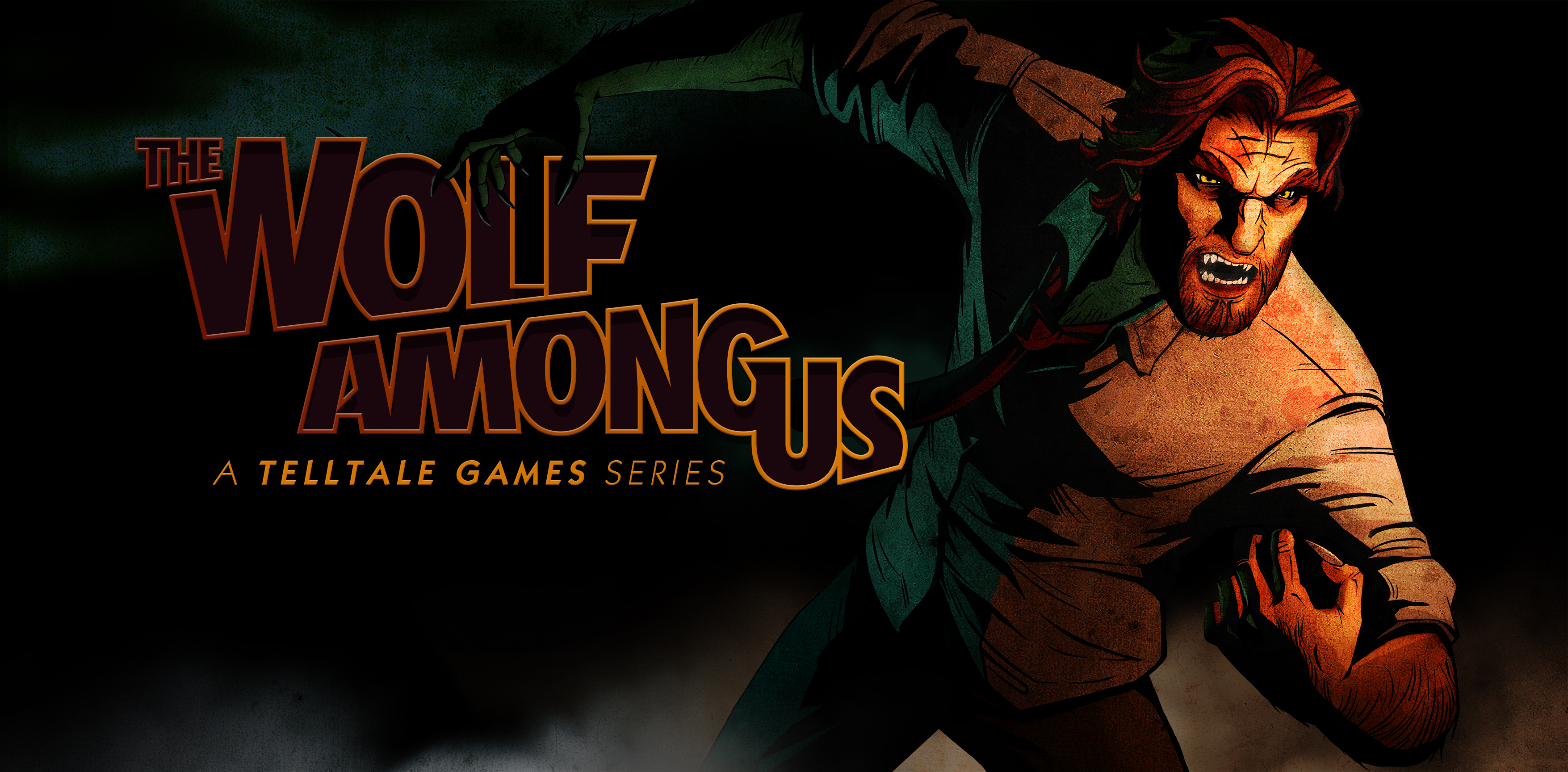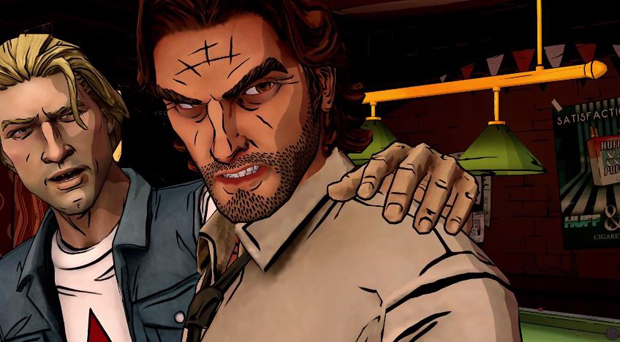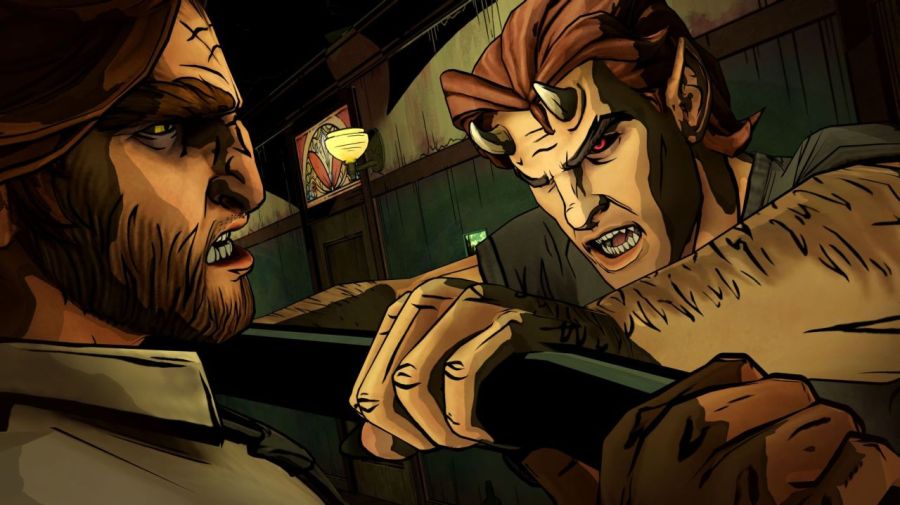The pages of any Raymond Chandler or Chester Himes novel can make almost any reader feel like a hardboiled gumshoe. You can live in the dark, twisted corners of fictionalized versions of real-life locales, dirtied by the urchins who grow in the mire. Many of these great noir detective stories are decades old, locked away in libraries or the memories of older generations. This year, Telltale finished a modern day pulp classic in the form of The Wolf Among Us.
Adapted from Bill Willingham’s Fables graphic novels, The Wolf Among Us plays prequel to the hit publication. You play Bigby Wolf, hardened peacekeeper of a neighborhood full of “Fables” – fairytale characters cast out of their storybook settings and into the real world. Part Detective Stabler and part Coffin Ed Jefferson, Bigby’s past life as The Big Bad Wolf has made him something people both hate and fear within the little borough of Fabletown. By the time you take your first drag of a Huff n’ Puff cigarette as the detective, Bigby has been worn down by the weight of his past wrongdoings. Keeping the peace between denizens or enforcing proper Glamour usage (glamours being spells used to make the less humanoid Fables look like humans) often turns into a contest of who can blame the most of their problems on the Sheriff.
The Fables’ collective stories serve as incredibly important points of exposition for everyone who lives in this neon, neo-noir, 70’s New York neighborhood. Bigby really was a Big Bad Wolf once, who really did blow houses down and attempt to murder Red Riding Hood. Characters like Beauty, Beast, Snow White, and Bluebeard all take their cues from their own respective stories – tales that dictate their relationships with one another. It’s a remarkably clever use of fairy tale lore to set a stage for a legitimately dark and adult story.
The story starts with a bang almost from the outset. Bigby answers a domestic disturbance call, where he and a belligerent Woodsman come to blows over the legendary lumberjack’s behavior towards Faith, a prostitute who had obviously come to blows with the man prior to your entry. The young woman’s death becomes the catalyst for the wild ride you’re taken on.
The Irrational Passions Team has gone into extreme detail about the story’s many nooks and crannies, and I won’t retread that ground here. However, the masterful way Telltale paces the murder mystery over the five-episode series is a display of their irreplaceable talent for characterization and creating heart-racing moments not built solely around action. The timed conversation points the developer is known for take front and center during the majority of the series. A fitting focus for a detective tale.
The dialogue sequences are the best Telltale has done by far, and it’s completely because of how grounded and human all of these characters are. Deep rooted and varied preconceptions about Bigby make choosing the “right” way to solve a problem more and more difficult as you go along. You never meet a character that has only one static opinion about you. There’s a great bit of tension in the general expectation that a character you may have wronged will probably be around in the future to give you trouble about it.
This is a stark difference from other franchises like The Walking Dead, where a “wrong” move commonly gets someone killed. Both stories use death as a major theme, but Wolf uses it less as a throw-away plot device and more as a reminder of the various levels of challenge being alive can pose sans zombie apocalypse.
As the focus on asking questions and doing detective work is pronounced, Bigby gets much of his opportunities to earn his reputation during the action scenes. For the most part, these sequences are well orchestrated scuffles designed to show off Bigby’s willingness to go the distance with some of Fabletown’s more surly folk. Their consequences have a more dramatic effect on the proceedings, because they also become moments of choice and consequences and can end with someone getting more than just their feelings hurt. Use your legendary strength to diffuse a situation quickly and protect your allies or lose control and send a message through with your fabled brutality. Even when you feel the choice is justified, the lasting effects are always varied and always matter.
It’s in the most hostile of moments that you feel most in sync with Bigby. Leading up to these climaxes, you serve more as his hands and feet, not his mind. He is his own man with his own opinions, and you make choices about whether to act on or suppress them. When a fight is on though, your symbiotic relationship is given definitive direction. Your frustrations are parallel – like Bigby, you know it didn’t have to come to this – and violence often feels like the only way to get straight answers from people or solve problems. It’s also heavily cathartic, and with this dynamic, you ARE the Big Bad Wolf. You get him. You’re not just pointing him in directions or picking the right response; you are doing what he’d do. The action sequences aren’t just strategically placed QTE’s. They are the load bearing pillars of your connection with Bigby.
Top notch voice acting by Adam Harrington also does its part in making Sheriff Wolf the fully featured character he is. Harrington’s turn as Wolf is his best performance yet. The nuanced feelings of confusion, frustration, and anger that spice every line he delivers as our protagonist is compelling and brilliant. He’s supported by some of the industry’s best talent, like Dave Fennoy and Gavin Hammon. There is no moment when the all-star cast felt like they weren’t exploring the best ways to make these characters sound as colorful as they looked.
Telltale’s strengths are all the strongest they’ve ever been during the course of WAU, and their weaknesses have improved as well. Non-PC versions of the game are reliably stable during moments that require the most interaction, but frame rates do slip regularly enough to be distracting. Also, some voice work tends to fall out of sync, and a rare crash or two are possibilities, though more of an issue in earlier chapters. Many of the more serious occurrences of these issues were few and far between, but still stand as an ugly scratch on an otherwise beautiful product.
Closing Comments:
There’s no adventure game quite like The Wolf Among Us. Yes, its bold and cartoony art design pay homage to license’s funny book origins ala Telltale’s The Walking Dead. It’s skeleton and basic design bullet points resemble the studio’s catalogue in superficial ways. And yet, no game from the Bay Area studio is as rife with genuine and unique idiosyncrasies as this one. It is obsessed with the reappropriation of old fiction – from the way the cast is defined by their accompanying childhood fables, to the grime-soaked noir world they all live in, to the somewhat antiquated Telltale style of point and click framework you play in. But it this blending of old storytelling and technology, and the selective tweaks to each ingredients contribution, that creates something altogether new and unmissable by anyone who wants to enjoy a good mystery.









